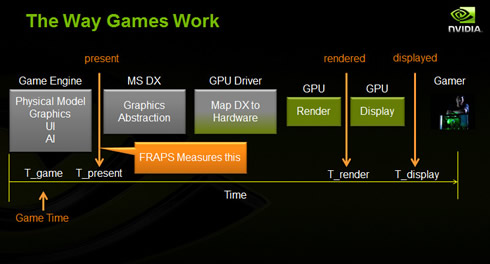
Nvidia Introduces The FCAT Frame Capturing Tool
Nvidia today released FCAT, a tool designed to accurately capture frames during gameplay. FCAT is a frame interval benchmark, designed to provide a clear picture of what?s happening at the end of the rendering pipeline.
Last year stuttering and frame interval benchmarking have become a very big deal in the world of GPUs. Stuttering issues were uncovered involving AMD?s as well as Nvidia's video cards.
The most common software tool for measuring a game's performance - FRAPs - doesn't always capture what users are seeing. Particularly when using multiple graphics cards, users are noticing that the action can often pause and stutter even when their software tools are telling them they should be seeing silky-smooth action.

The problem is that FRAPs accurately measures frames when they are transferred from a game engine. But a lot happens between that point and when a game gets to the screen. There can be a big difference between what users see on FRAPs and what they experience.
Two of the problems: what Nvidia calls 'drops' and 'runts.' Drops occur when frames that are counted by FRAPs are never displayed. Runt frames, by contrast, are displayed, but only for a few lines of the full 1080p that should be displayed.
Sometimes these drops and runts can cause visible 'tears' in the scene being put on the screen. Other times they?re too small to see, but like drops they break the smooth flow of the onscreen action, resulting in a stuttery experience.
So, Nvidia devised a solution that the company calls Frame Capture Analysis Tools or FCAT.
Capturing the data and properly analyzing it includes the use of a special capture card, special overlay software that shows a 'color bar,' or fixed color sequence on the display, and scripts that help analyze and graph the data.

By using the capture card with the on-screen color bar the tool compares the content that?s actually shown on the screen with what it should be there and correlate that to what the real gaming experience is.
Nvidia is opening up its FCAT solution, making the scripts and software associated with FCAT freely-modifiable and redistributable.
The most common software tool for measuring a game's performance - FRAPs - doesn't always capture what users are seeing. Particularly when using multiple graphics cards, users are noticing that the action can often pause and stutter even when their software tools are telling them they should be seeing silky-smooth action.

The problem is that FRAPs accurately measures frames when they are transferred from a game engine. But a lot happens between that point and when a game gets to the screen. There can be a big difference between what users see on FRAPs and what they experience.
Two of the problems: what Nvidia calls 'drops' and 'runts.' Drops occur when frames that are counted by FRAPs are never displayed. Runt frames, by contrast, are displayed, but only for a few lines of the full 1080p that should be displayed.
Sometimes these drops and runts can cause visible 'tears' in the scene being put on the screen. Other times they?re too small to see, but like drops they break the smooth flow of the onscreen action, resulting in a stuttery experience.
So, Nvidia devised a solution that the company calls Frame Capture Analysis Tools or FCAT.
Capturing the data and properly analyzing it includes the use of a special capture card, special overlay software that shows a 'color bar,' or fixed color sequence on the display, and scripts that help analyze and graph the data.

By using the capture card with the on-screen color bar the tool compares the content that?s actually shown on the screen with what it should be there and correlate that to what the real gaming experience is.
Nvidia is opening up its FCAT solution, making the scripts and software associated with FCAT freely-modifiable and redistributable.





















